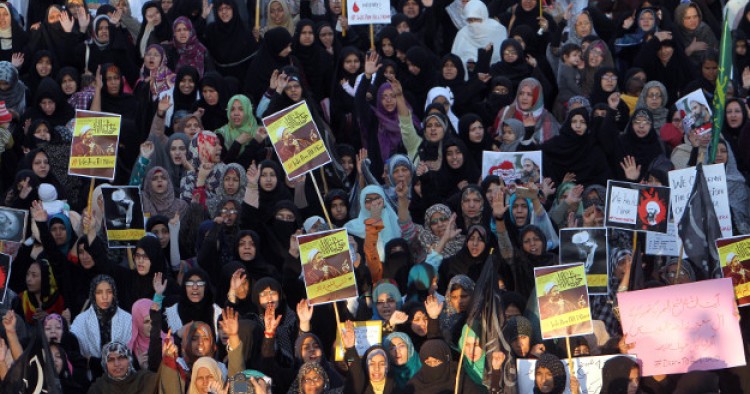Saudi Arabia is back, knocking on Pakistan’s door. Saudi Foreign Minister Adel al-Jubeir and King Salman bin Abdulaziz al-Saud’s son and deputy crown prince, Mohammad bin Salman, arrived separately in the early days of the new year to persuade Islamabad to join hands with Riyadh in confronting regional security threats. That is, the Saudis want Pakistan’s support against Iran.
From Riyadh’s perspective, Pakistan, which is home to the world’s second-largest Muslim population and is the only nuclear-armed Islamic country, provides much needed critical mass. The Saudis wish to see Islamabad publicly commit itself to the 34-nation, Saudi-led antiterrorism coalition that Riyadh launched in December. But Riyadh would settle for Pakistan issuing stronger and more frequent diplomatic gestures of support for Saudi regional policies. Such support has been hard to win, however. In April 2015, when Riyadh sought Islamabad’s military assistance in its newly launched war in Yemen, Saudi officials went home empty-handed.
This time, Jubeir and bin Salman heard two different messages from Islamabad. The head of the Pakistani military, General Raheel Sharif, vowed a “strong response” to any threat to Saudi security. The other message was from Prime Minister Nawaz Sharif. His emphasis was on a potential role for Pakistan as a mediator between Saudi Arabia and Iran, sensibly sidestepping the burden of having to pick sides.
History reveals that it is Sharif’s promise of neutrality—bordering on opportunism—that most likely will shape Islamabad’s attitude toward this latest Iranian-Saudi spat. Since its independence in 1947, Pakistan has often found itself in a position to choose between the Iranians and the Arabs. More often than not, Islamabad has managed to wriggle free. In fact, it has repeatedly benefited from being in that position in the first place.
What history also shows is that it is cold geopolitical calculations—not sectarian sympathies—that will fashion Islamabad’s approach. Today, Pakistan has much closer ties to the Arab countries of the Persian Gulf and particularly Saudi Arabia, home to millions of Pakistani expatriates and a source of subsidized oil and other financial incentives. But Iran is a large immediate neighbor and a nuclear-threshold state looking to emerge from years of international isolation. These factors compel Islamabad to give Iran another look as it weighs Saudi requests for support.
TENSIONS
The mainstream narrative holds that the Iranian-Pakistani relationship ran aground after the 1979 Iranian revolution, which brought to power a revolutionary Shiite Islamist regime in Tehran and gave Sunni Arab nations an opening to court Islamabad. As Time magazine put it last week, Iranian-Pakistani relations have been “fraught since . . . Ayatollah Ruhollah Khomeini came to power and Tehran drifted closer to New Delhi.” In fact, it was another Iranian leader, the secular and pro-Western Mohammad Reza Pahlavi, shah of Iran, who a decade before Khomeini came to power had already set in motion the forces that turned Tehran and Islamabad from allies to rivals.
When Pakistan was born in 1947, the anticommunist shah of Iran feared that the impoverished and fragmented nation would succumb to Soviet machinations. He heaped aid, cash, and diplomatic support on Pakistan, most notably during Pakistan’s wars of 1965 and 1971 with India. But two Pakistani positions irked the shah.
First were Pakistan’s demands that he blackball India. He refused to do so, asking on May 17, 1974, “Is it possible for Pakistan to fight India and win?” Second, he was even more riled when Pakistan set its eyes on the oil-rich Arab states of the Persian Gulf to fund its military race against India. When, in 1968, the United Kingdom stated its intentions to withdraw from the region, Pakistan toyed with the idea of becoming a military guardian and sent the first of several large batches of Pakistani troops to the Gulf states.
In the end, Pakistani President Muhammad Ayub Khan opted not to challenge the shah’s plans to become the chief military power in the Persian Gulf. Fortunately for Tehran, meanwhile, U.S. President Richard Nixon favored Iran to replace the British, and so the Pakistanis backed off. But the slow rupture in Iranian-Pakistani ties had begun. And neither sectarianism nor any other historic issue had anything to do with it. In fact, the words “Shiite” and “Sunni” barely appear in the many declassified U.S. and British intelligence reports that assessed Iranian-Pakistani relations at the time—in those days, another term was more telling: “Mr. Bhutto is so anxious to please the Arabs,” the shah said of Pakistani Prime Minister Zulfikar Ali Bhutto, “that he's even started talking about the ‘Gulf’ without a hint of the all-important adjective ‘Persian.’ If he wants cheap oil, then he should damn well sort something out with his Arab friends.”
LOOK OUT
Even if the Shiite-Sunni divide was a nonissue, the Iranian-Arab schism was real, and it did put Pakistan in a bind. In February 1974, the shah famously refused to attend Bhutto’s Islamic Conference in Lahore simply because Saudi King Faisal apparently chose the conference date. “Why the hell should I let Faisal dictate the date?” the shah had asked his closest advisers. The episode was frivolous, but it is also one of the earliest public fallings-out as Iran and Saudi Arabia each courted Pakistan. In the end, Pakistan secured millions in Arab financial pledges at the conference. That Bhutto was Pakistan’s most prominent Shiite politician had little to do with anyone’s calculations.
The Middle East Institute (MEI) is an independent, non-partisan, non-for-profit, educational organization. It does not engage in advocacy and its scholars’ opinions are their own. MEI welcomes financial donations, but retains sole editorial control over its work and its publications reflect only the authors’ views. For a listing of MEI donors, please click here.













